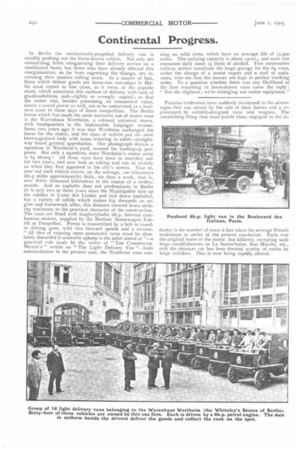Continental Progress.
Page 12

If you've noticed an error in this article please click here to report it so we can fix it.
In Berlin the mechanically-propelled delivery van is steadily pushing out the horse-drawn vehicle. Not only are enterprising firms reorganising their delivery service on a mechanical basis, but firms who have already effected this reorganisation, so far from regretting the change, are increasing their modern rolling stock. As a matter of fact, firms which deliver goods per horse-van nowadays in Berlin must expect to lose caste, as it were, in the popular mind, which associates this method of delivery with lack of go-aheadedness, and—rightly or wrongly-capital ; so that the motor van, besides possessing an economical value, exerts a moral power as well, not to be underrated as a business asset in these days of fierce competition. The Berlin house which has made the most extensive use of motor vans is the Warenhaus NiVertheim, a colossal universal stores, with headquarters in the fashionable Leipziger strasse. Sonic two years ago it was that Wertheim exchanged the horse for the motor, and the class of vehicle put on—neat brown-grained body with brass lettering in relief—straightway found general approbation. Our photograph depicts a squadron in Wertheim's yard, massed for loading-up purposes. But only a squadron, since Wertheim's motor army is 64 strong ! All these vans have been in everyday use for two years, and now look as taking and run as sweetly as when they first appeared in the city's streets. Year in, year out each vehicle covers, on the average, too kilometres (62.5 miles approximately) daily, six days a week, that is, over thirty thousand kilometres in the course of a twelvemonth. And as asphalte does not predominate in Berlin (it is only two or three years since the Municipality tore up the cobbles in Unter den Linden and laid down asphalte), but a variety of cobble which makes big demands on engine and framework alike, this distance covered hears striking testimony to the practical character of the construction. The vans are fitted with single-cylinder 6h.p. internal combustion motors, supplied by the Berliner Motorwagen Fabrik at Tempelhof. Power is transmitted by a belt to casedin driving gear, with two forward speeds and a reverse. "All idea of running upon pneumatic tyres must be absolutely discarded if economic upkeep is the point aimed at "—a practical rule made by the writer of " TnE COMMERCIAL Muroa's " article on "The Light Delivery Van "—finds substantiation in the present case, the Wertheim vans run ningon solid tyres, which have an average life of 12,500 miles. The carrying capacity is about iscwt., and each van consumes daily some 15 litres of alcohol. Five consecutive railway arches constitute the huge garage for the 64 vans, under the charge of a motor expert and a staff of assistants, who see that the motors are kept in perfect working order. To a question whether there was any likelihoodof the firm returning to horse-drawn vans came the reply : " Not the slightest ; we're enlarging our motor equipment."
Parisian tradesmen have suddenly awakened to the advantages they can secure by the sale of their horses and a replacement by suitably-designed vans and wagons. The astonishing thing that must puzzle those engaged in the in dustry is the number of years it has taken the average French tradesman to arrive at the present conclusion. Paris was the original home of the motor, but hitherto, excepting such large establishments as La Samaritaine, Bon Marche, etc., only the pleasure car has been deemed worthy of notice by large retailers. This is now being rapidly altered.
















